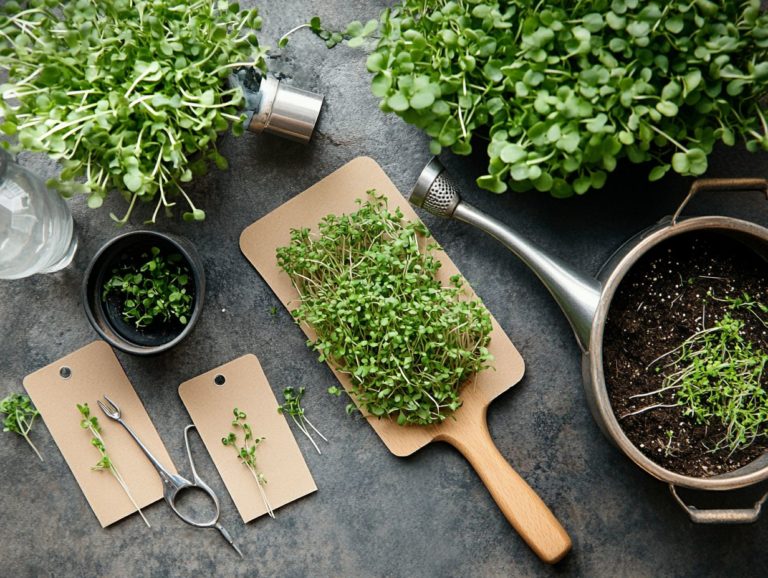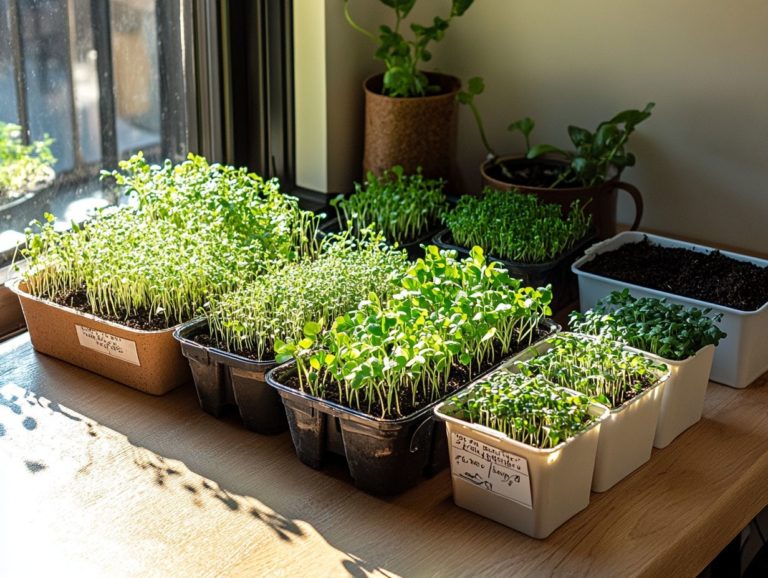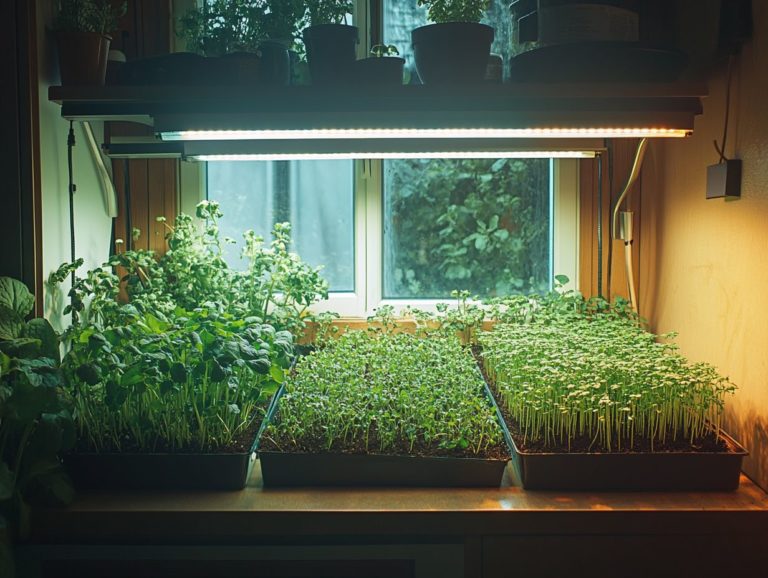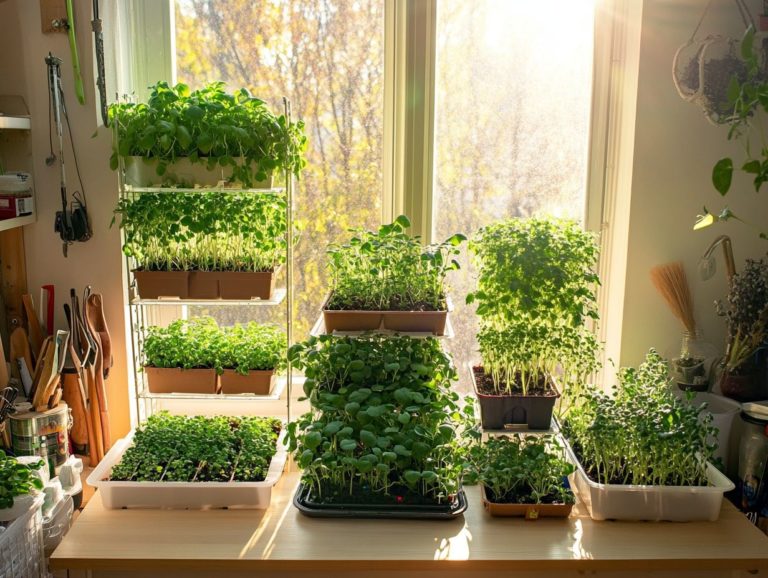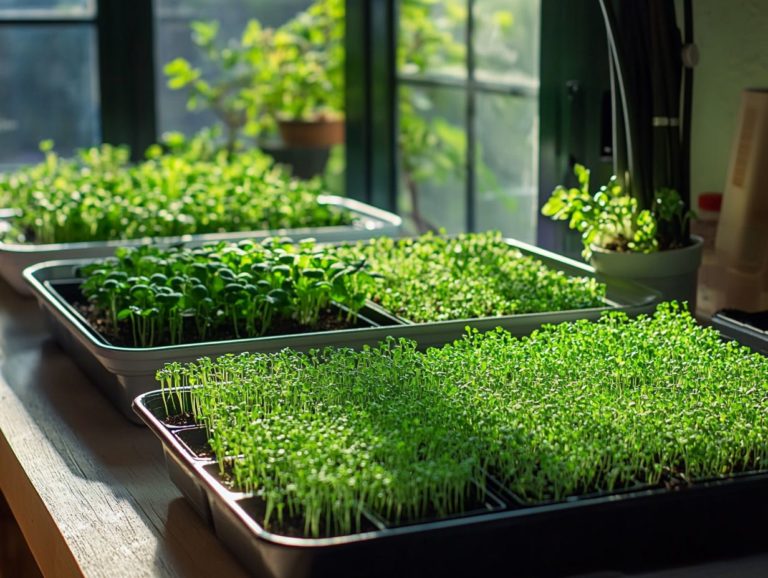How to Design a Microgreen Workspace
Microgreens are delightful, nutrient-dense plants that have recently captured the attention of culinary enthusiasts and wellness advocates alike. Their vibrant hues and robust flavors enhance your dishes and offer a multitude of health benefits.
If you’re keen on growing your own microgreens, this guide will help you get started. You ll learn how to select the ideal location, gather the right supplies, and nurture your greens effectively.
Explore imaginative ways to weave these tiny powerhouses into your meals and home d cor. Whether you re a seasoned gardener or just starting out, cultivating microgreens promises to be a fulfilling and sustainable journey. Don t miss out on the chance to grow your own fresh greens!
Contents
- Key Takeaways:
- Benefits of Microgreen Workspaces
- Designing a Microgreen Workspace
- Setting Up Your Microgreen Workspace
- Caring for Your Microgreens
- Creative Uses for Microgreens
- Frequently Asked Questions
- 1. How do I select the right location for my microgreen workspace?
- 2. What materials should I use for my microgreen workspace?
- 3. How can I set up a system that waters your plants automatically?
- 4. Can I use any type of soil for growing microgreens?
- 5. How much light do my microgreens need to thrive?
- 6. How do I maintain proper hygiene in my microgreen workspace?
Key Takeaways:
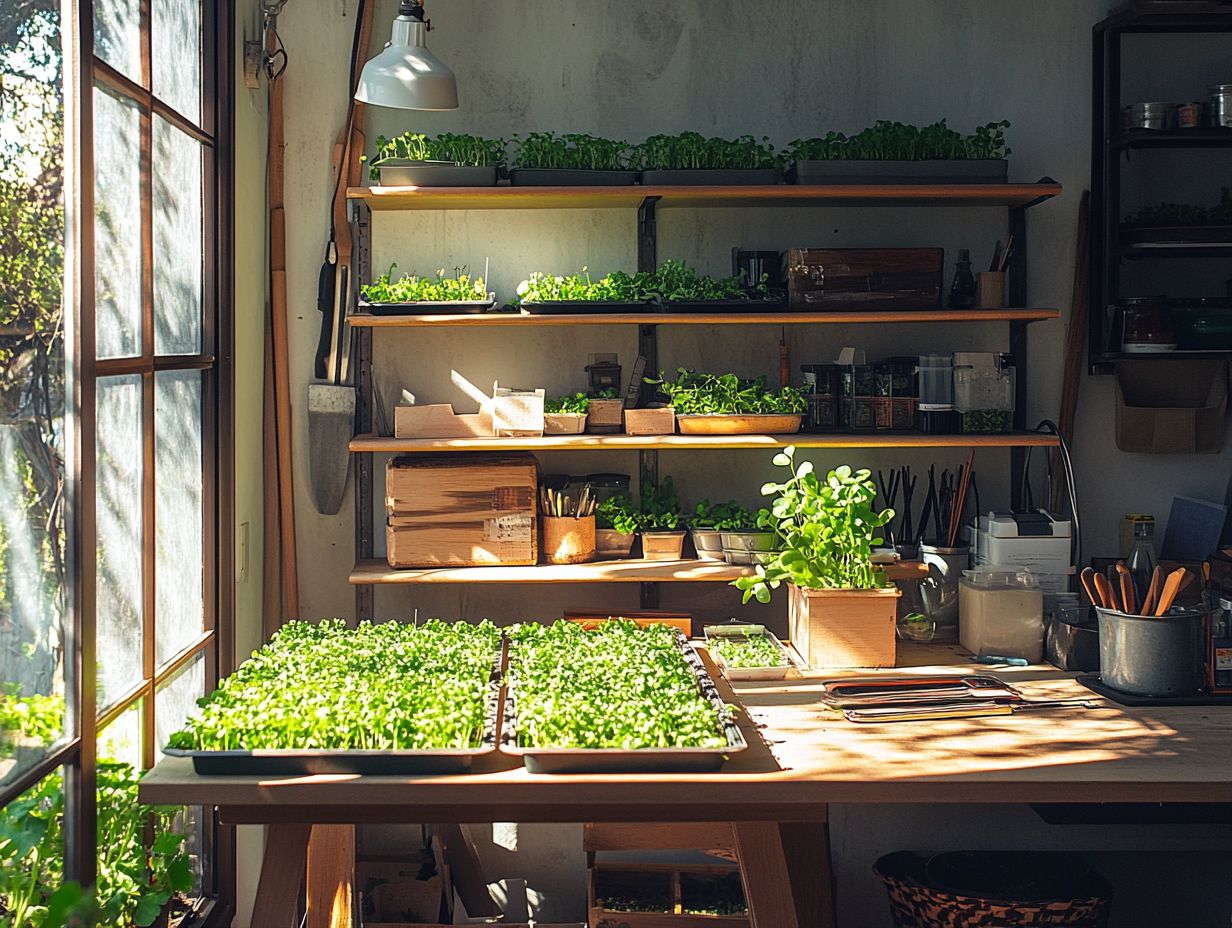
- Create a healthy and eco-friendly workspace by incorporating microgreens.
- Choose the right location and gather necessary supplies and equipment for your microgreen workspace.
- Follow step-by-step instructions and proper care tips to set up and maintain your microgreen workspace successfully.
What are Microgreens?
So, what exactly are microgreens? They are young, edible plants that you can harvest shortly after they germinate, typically within 7 to 21 days of planting. You can cultivate them in grow trays, which are containers designed specifically for growing plants, using various mediums like soil, water, or reusable mesh.
Microgreens are packed with intense flavors and vibrant colors. These nutrient-dense greens are taking the culinary world by storm and gaining traction in home gardening and commercial production. As people increasingly seek fresh ingredients, microgreens are becoming a go-to choice. You can grow them indoors or outdoors, depending on the climate you desire.
There are various types of microgreens arugula, radish, basil, and sunflower, to name a few that thrive under specific growing conditions, often requiring ample but indirect light. Their impressive nutritional benefits, rich in vitamins C, E, and K, are a major draw for health-conscious consumers.
The rising demand in the horticultural sector has spurred exploration of innovative growing techniques. For instance, special lights that help plants grow better indoors provide the optimal light spectrum needed for photosynthesis. This technology ensures a consistent supply of fresh microgreens year-round, making them a staple in urban farms and home gardens alike.
Benefits of Microgreen Workspaces
Establishing a dedicated microgreen workspace presents many advantages for your personal health and the environment. It’s an appealing choice for urban gardeners and health aficionados.
Microgreens are brimming with essential nutrients, vitamins, and minerals. They offer a swift and effortless way to elevate your dietary intake while championing sustainable growing practices.
With the right supplies like a thoughtfully designed grow room outfitted with energy-efficient LED lights and effective climate control measures you can optimize the growth of these vibrant greens while minimizing your environmental footprint.
Ready to get started? Let s dive in!
Health and Environmental Benefits
Microgreens are a powerhouse of nutrients and a boon for environmental sustainability. They offer a remarkable advantage for those who prioritize both health and eco-conscious living.
Research indicates that these tiny greens can pack up to 40 times the nutrients found in their fully grown counterparts. They deliver a concentrated burst of vitamins, minerals, and antioxidants.
By cultivating microgreens indoors with efficient systems, you can reduce your reliance on store-bought produce. This ultimately lowers your carbon footprint and supports local ecosystems.
These nutrient-dense plants are more than just a garnish. They can enhance immune function and provide anti-inflammatory benefits, playing a vital role in addressing various health challenges.
For example, adding radish and broccoli microgreens to your meals can significantly boost heart health. Meanwhile, pea shoots offer a delightful, low-calorie alternative to unhealthy snacks.
Their rapid growth and ability to thrive in compact spaces promote sustainable living practices. This helps to mitigate food waste that often plagues conventional agriculture.
By opting for microgreens instead of processed food options, you re not just nourishing your body you re also contributing to the collective effort for a greener planet.
Designing a Microgreen Workspace
When you set out to design your microgreen workspace, paying meticulous attention to layout and equipment can markedly elevate your plants’ growth potential.
From choosing the right grow rack or Danish trolley to optimizing space with towering stacks of grow trays, every detail plays a crucial role in the efficiency and productivity of your workspace.
Integrating features like full-spectrum LED lights, proper ventilation, and climate control devices such as temperature monitors, heaters, and dehumidifiers is essential for creating optimal growing conditions.
Choosing the Right Location

Selecting the right location for your microgreen workspace is essential for their growth and overall productivity. This applies whether you choose to garden indoors or outdoors.
A space that basks in ample natural light is ideal, as microgreens flourish in bright, indirect sunlight.
If natural light is limited, full-spectrum LED lights can create the perfect conditions for growth. Accessibility is another key factor; having easy access to water and tools can significantly streamline your gardening process.
It s also vital to monitor environmental conditions like temperature and humidity to cultivate a climate that encourages healthy growth.
By incorporating smart sensors and automatic watering systems, you can further optimize your setup. This technology ensures your microgreens receive the perfect balance of light and moisture, resulting in lush and vibrant yields.
Supplies and Equipment Needed
To successfully cultivate microgreens, you’ll need a selection of supplies and equipment to create an efficient and productive workspace.
Investing in quality lighting, such as LED grow lights, can significantly elevate your growing experience. These lights provide the ideal spectrum for optimal growth while being energy-efficient.
Using flood trays can streamline your watering process, delivering uniform moisture across the surface and minimizing the risk of uneven growth.
If you’re exploring alternatives, consider PVC connectors; they are fantastic for constructing customized shelving or support systems that make the most of vertical space in smaller areas.
Each of these components is essential for nurturing healthy microgreens, ensuring a vibrant yield that boosts your personal health and sparks your culinary creativity.
Start growing your own microgreens today and reap the health and environmental benefits!
Setting Up Your Microgreen Workspace
Establishing your microgreen workspace requires a careful planning approach to create optimal conditions for plant growth. Start by selecting a clean and organized area that is fully equipped with all the necessary supplies.
Choose a suitable grow rack or shelving unit that accommodates high stacks of grow trays and allows ample space for air circulation between them. You can use automated watering systems and full-spectrum grow lights to ensure consistent moisture and lighting.
Employing climate control devices will help you monitor temperature and humidity levels, creating the ideal environment for your microgreens to thrive.
Step-by-Step Instructions
To set up your microgreen workspace successfully, follow these step-by-step instructions from the initial preparation to the final planting stage. Start by selecting a clean area that meets your light and climate requirements, ensuring there s adequate ventilation for optimal air circulation.
Next, arrange your grow trays or flood trays on the chosen grow rack. Adjust the shelf heights as needed to create the perfect distance for growth. Carefully add your chosen growing medium and plant the seeds.
Then, establish an efficient watering setup along with monitoring devices for temperature and humidity. Once your area is prepared and the trays are in place, distribute the seeds evenly to avoid overcrowding, which promotes healthy growth.
Consider using a spray bottle to mist the seeds gently; this will help them settle into the growing medium without washing them away. Implementing a consistent light schedule is crucial aim for 12-16 hours of light each day to support robust growth while avoiding direct contact.
Regularly check the moisture level of the medium. Don t wait too long to check moisture levels your microgreens depend on you! Use thermometers and hygrometers to monitor temperature and humidity, making adjustments as necessary to cultivate a thriving environment for your microgreens.
Caring for Your Microgreens
To grow amazing microgreens, you need to care for them every step of the way! Caring for your microgreens throughout their growth cycle is crucial for achieving high yields and preserving the quality of your plants.
This means focusing on consistent watering, proper lighting, and timely harvesting to ensure optimal flavor and nutrient content. It s essential to monitor the growth conditions, including light configurations and shelf distance, and make necessary adjustments to your watering system.
Providing just the right amount of moisture is key too much can lead to waterlogging, while too little can stunt growth. Your attentive care will yield a flourishing crop.
Watering, Lighting, and Harvesting Tips
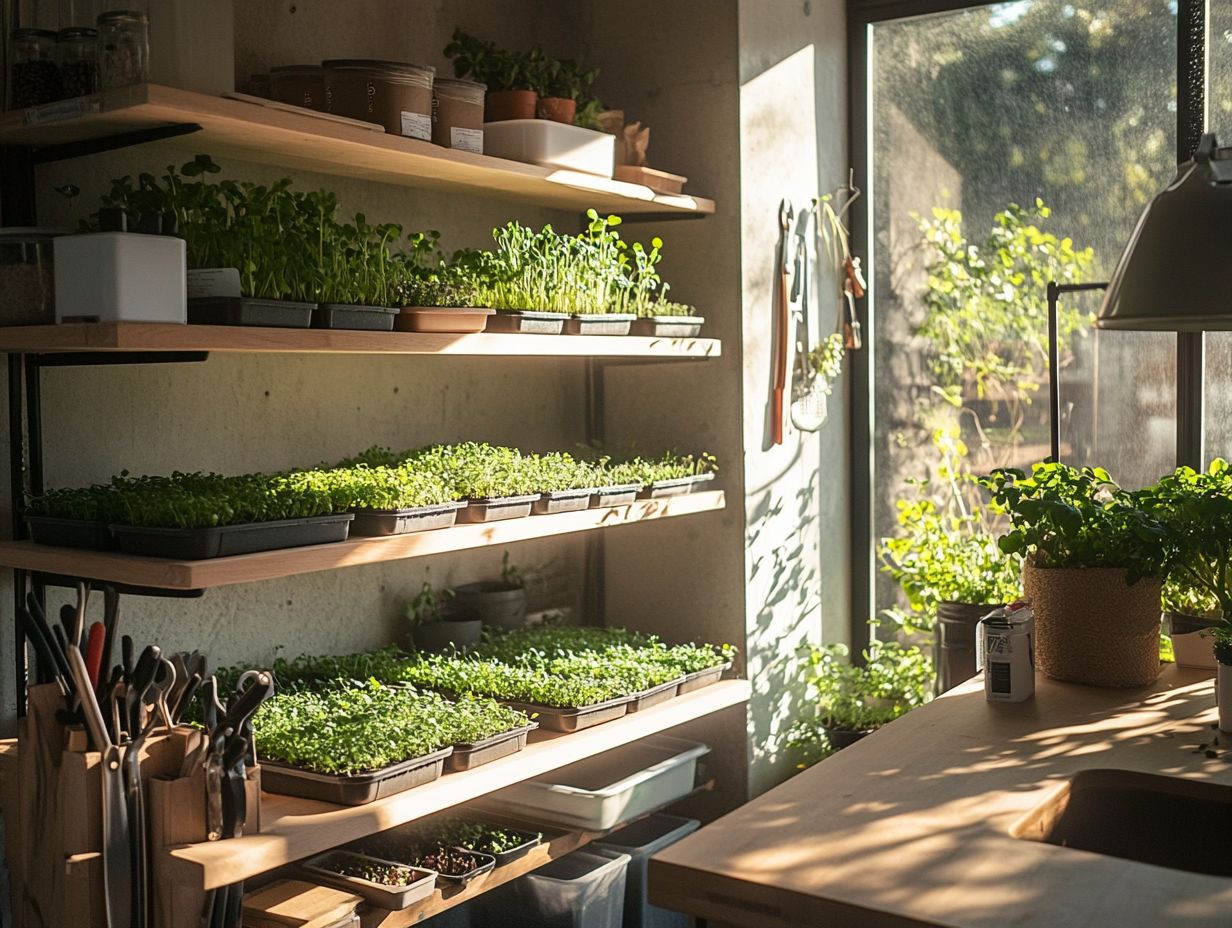
To achieve the finest results in growing microgreens, it s essential to implement effective techniques in watering, lighting, and harvesting. Understanding the intricacies of each element can significantly elevate the yield and taste of these nutrient-dense greens.
Regularly check the moisture level of your grow medium; microgreens thrive on consistent watering, but they re quick to suffer from overwatering. Consider using a watering nozzle or an automated system to streamline this process.
Make sure your grow lights are set to the correct specifications, providing full spectrum light for about 12-16 hours a day to replicate ideal daylight conditions. For harvesting, wielding sharp, sterile scissors is vital for making clean cuts that encourage healthy regrowth.
This not only enhances flavor but also extends the growing cycle, allowing your greens to reach their peak flavor and nutritional potential.
Remember these key points for success: choose the right setup, monitor conditions, and care diligently for your microgreens. Are you ready to grow your own microgreens?
Creative Uses for Microgreens
Microgreens are incredibly versatile ingredients that you can creatively incorporate into various cooking uses, each offering both health benefits and flavor enhancement to your dishes.
Whether you’re tossing them into salads, layering them in sandwiches, or using them as garnishes for soups and entr es, these tiny greens provide a delightful burst of flavor alongside great nutrition.
Beyond their taste, microgreens can also elevate the aesthetic appeal of your meals, transforming presentations into visual masterpieces. No wonder everyone loves them! They ve become a favored choice for both chefs and home cooks alike.
Incorporating Microgreens into Your Meals and Decor
Incorporating microgreens into your meals and decor can truly elevate both the nutritional value and visual appeal of your culinary creations. These vibrant greens work wonders as toppings for a variety of dishes think salads, sandwiches, and soups.
Use careful plating to showcase microgreens, enhancing the overall presentation and making your meals look not just inviting but gourmet.
To fully savor the benefits of microgreens, try using them in recipes like omelets. Their peppery notes complement eggs beautifully. For a refreshing salad, pair them with citrus segments and avocado, allowing those textures and flavors to shine together. If you’re interested in expanding your gardening, consider checking out how to grow microgreens in a small space to maximize your growing area.
Regarding presentation, consider a minimalist approach: sprinkle a handful of microgreens atop a vibrant dish or create height by stacking layers of food. A drizzle of high-quality olive oil or balsamic reduction can further accentuate those miniature greens, transforming each plate into not just a meal but a work of art that captures both taste and health.
Frequently Asked Questions
1. How do I select the right location for my microgreen workspace?
When designing a microgreen workspace, it is important to choose a location that receives ample natural light, has good air circulation, and is away from any potential sources of contaminants such as chemicals or pets.
2. What materials should I use for my microgreen workspace?
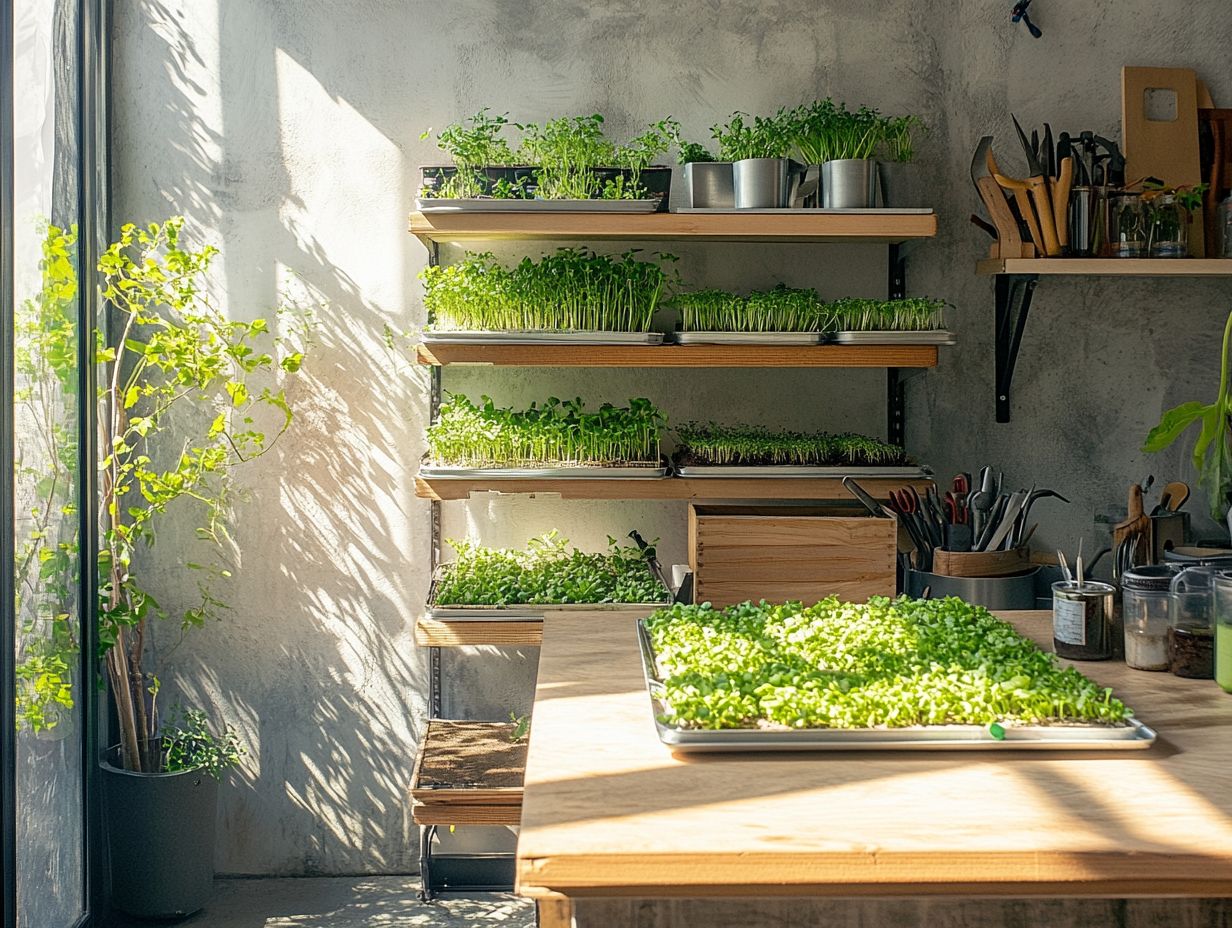
The ideal materials for a microgreen workspace include food-safe plastic trays, organic potting soil, and a water source. You may also want to consider adding shelving, grow lights, and ventilation fans for optimal growth.
3. How can I set up a system that waters your plants automatically?
A simple and effective way to set up an automated watering system for your microgreen workspace is by using a drip tray and a reservoir. The drip tray collects excess water, and the reservoir can be filled as needed to keep the grow medium moist. Alternatively, you can also use a misting bottle to manually water your microgreens.
4. Can I use any type of soil for growing microgreens?
While some gardeners may advise using potting mix or compost for microgreens, it is best to use a specific type of soil made for microgreens or seed starting. These soils are lighter in texture and have the right balance of nutrients for optimal growth.
5. How much light do my microgreens need to thrive?
Microgreens require at least 6-8 hours of light per day to grow properly. If you are growing your microgreens indoors, you may need to supplement with grow lights to ensure they get enough light. Avoid placing the microgreens in direct sunlight, as this can cause them to wilt or burn.
6. How do I maintain proper hygiene in my microgreen workspace?
To maintain proper hygiene in your microgreen workspace, make sure to clean your equipment, trays, and work surfaces before and after each use. Also, avoid using any chemicals or pesticides in your workspace and wash your hands before handling the microgreens.

